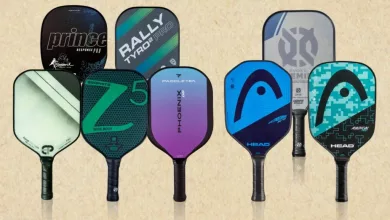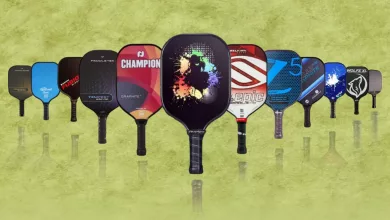Graphite vs Composite Pickleball Paddles: Full Comparison
Table of Contents
If you’re searching for a new pickleball paddle, chances are you’ve seen a lot of talk about composite and graphite paddles. These types of paddles have very different strengths and weaknesses so it’s very important to be aware of these differences before you purchase a paddle. At the point when you step onto the pickleball court, your decision of which paddle you choose can greatly affect your game. It’s crucial to go with an educated choice, particularly about the two noticeable choices: graphite and composite pickleball paddles.
In this thorough comparison, we’ll dive further into the distinctions between these paddle types and what they mean for your game concerning control, spin, and power. Toward the end of this article, you’ll have an unmistakable comprehension of which paddle suits your playing style and inclinations.

What are Graphite and Composite Pickleball Paddles?
Before we dig into the subtleties, we should lay out a strong comprehension of what graphite and composite pickleball paddles are:
Graphite Pickleball Paddles
Graphite paddles are created from layers of graphite material, which is notable for its lightweight and responsive properties. These paddles are leaned toward by players who focus on control and accuracy in their shots. Because of their exceptional development, graphite paddles will generally be moderately light and flexible.
Composite Pickleball Paddles
Then again, composite paddles are made by mixing different materials, including fiberglass, carbon fiber, and other composite materials. While they might be marginally heavier than graphite paddles, they offer upgraded power and strength. Composite paddles are famous among players who look for strong crushes and pattern shots.
Since we have a reasonable image of what these paddle types are we should look at how they impact your game concerning control, spin, and power.
Control
Graphite Paddles: With regards to control, graphite paddles are often thought about as top-level. Their lightweight nature takes into consideration speedy mobility at the net, making them the favored decision for exact shots, dinks, and volleys. Players who esteem artfulness and shot position view graphite paddles as a characteristic fit for their playing style.
Composite Paddles: While composite paddles offer great control, they may not match the pinpoint accuracy of graphite paddles. Notwithstanding, they work out some kind of harmony among control and power, making them reasonable for an extensive variety of playing styles. If flexibility is what you are looking for, composite paddles could be your optimal decision.
Spin
Graphite Paddles: Graphite paddles may not normally produce as much spin as their composite partners because of their smoother surface. Be that as it may, players with solid wrist activity can in any case grant a lot of spin. It’s crucial to note that graphite paddle plans have developed, and some more current models presently incorporate finished surfaces for upgraded spin potential.
Composite Paddles: With regards to creating turns, composite paddles enjoy a benefit. Their finished surfaces grasp the ball better, making it simpler to execute turn shots like topspin or cut. If you depend on twists to outsmart your rivals, a composite may be the ideal decision for you.
Power
Graphite Paddles: While graphite paddles succeed in charge, they might miss the mark on crude power that composite paddles can convey. On the off chance that you’re a forceful player who depends on roaring serves and gauge power shots, you might find graphite paddles less fit to your playing style.
Composite Paddles: On the off chance that you’re a forceful player who loves to overwhelm the court with strong crushes and gauge shots, a composite paddle is possibly your go-to choice. The additional weight and stiffer development of composite paddle take into account more powerful shots that can keep your adversaries on edge.
Which Paddle Is Right for You?
Now that we’ve investigated the qualities of graphite and composite pickleball paddles, now is the right time to consider which one lines up with your playing style and inclinations. Here are a few critical elements to assist you with pursuing an educated choice:
Graphite Paddle: Select a graphite paddle if you focus on control, artfulness, and fast responses at the net. An amazing decision for players to esteem contact, position, and volleying ability over power.
Composite Paddle: If you’re a forceful player who depends on strong shots, crushes, and spin to acquire an edge on the court, a composite paddle is reasonably the better decision. Composite paddles give a mix of control and power that suits an overall playing style.
See also -> Fiberglass vs Graphite paddles
Conclusion
About pickleball, picking the right paddle is pivotal to your presentation on the court. The paddle you select can incredibly influence your control, power, artfulness, and spin potential. It’s vital to consider your playing style and inclinations while settling on this choice.
Graphite paddles are known for their control and artfulness. They offer a responsive touch and take into consideration exact shots. If you focus on exactness and situation over power, a graphite paddle might be the best decision for you.
Then again, composite paddles are famous for their power and maximizing spin. They frequently have a bigger perfect balance and give all the more pop off the paddle face, taking into consideration harder hits and expanded turns. If you lean toward a more forceful and strong playing style, a composite may be the better choice for you.
Finally, the ideal pickleball paddle for you, at last, relies upon your singular assets and necessities as a player. Carve out the opportunity to assess your game, evaluate your assets and shortcomings, and consider what elements mean a lot to you. Is it true that you are hoping to work on your control, increment your power, upgrade your twist, or track down a harmony between each of the three?
When you have a reasonable comprehension of your game and what you esteem the most, you can go with an educated choice when choosing your pickleball paddle. There are different elements to consider, for example, weight, grasp size, paddle face surface, and commotion level. Trying different things with various paddles and looking for guidance from experienced players can likewise assist you with viewing as the ideal fit.
Keep in mind, that the right paddle is certainly not a one-size-fits-all arrangement. An individual decision can enormously influence your delight and accomplishment on the court. In this way, take as much time as necessary, accumulate data, and pick the pickleball paddle that will help you succeed and completely partake in each snapshot of your game.


